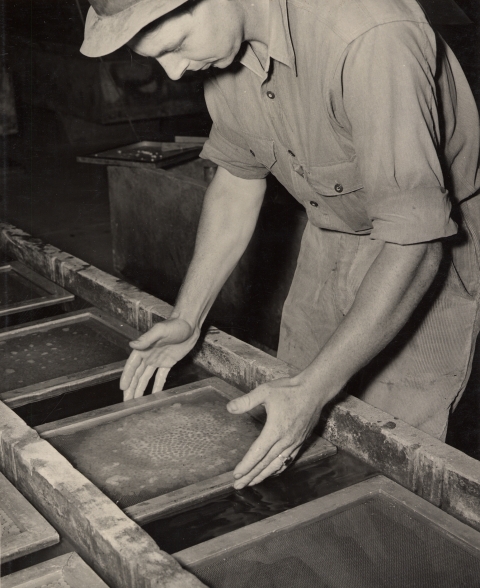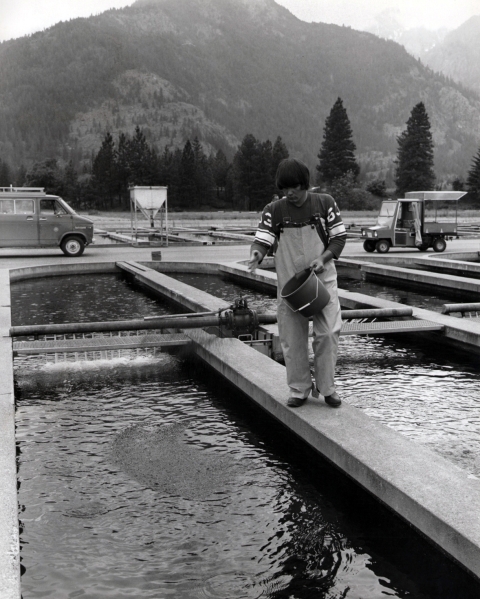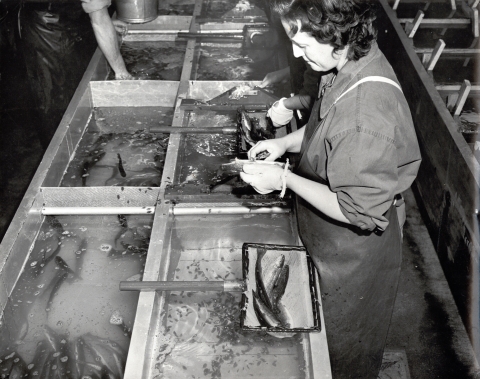When Grand Coulee Dam was built on the Columbia River in the 1930s, hundreds of miles of river were closed to salmon and steelhead. Three hatcheries were built to compensate for lost habitat and keep fish numbers high, and to serve tribal, commercial, and sport fisheries. Entiat, Leavenworth, and Winthrop national fish hatcheries still do this today. Since we opened in 1940, our mission has never changed, but how we do our work has.
Each hatchery raises different fish. As of 2017, Leavenworth raises spring Chinook salmon. Entiat raises summer Chinook salmon. Winthrop raises coho and spring Chinook salmon and steelhead. The Yakama Nation raises coho salmon at Leavenworth and cares for some steelhead at Winthrop.
Starting a New Generation
The lifecycle of the spring Chinook salmon begins each September at Leavenworth and Winthrop hatcheries, when eggs are placed in incubation trays. At Leavenworth, wooden trays used to be pinned together in stacks and placed in concrete troughs in the nursery building. Staff began using stacking trays in 2007. They use less water and are healthier for fish.
Dead eggs turn white with fungus, and staff and volunteers take those out of the trays to keep the rest healthy. Just before the eggs hatch, black dots appears: the eyes of the fish.
Alevins Emerge
Alevins (pronounced AL-uh-vin), also called sac fry, hatch with yolk sacs still attached. Unable to eat, they rely instead on the yolk to feed them.
Once the alevins grow into fry and begin to eat, they are moved from the egg trays to large troughs located in the nursery building. The original concrete troughs have been replaced with fiberglass.
Fingerlings Flourish
When fry have grown and gained fully developed scales and fins, they are called fingerlings. In earlier days, some fingerlings ate more and grew faster than others. Staff then used grading boxes to sort them for size. Today, hatchery fish are fed by hand and closely watched, so they grow more evenly and sorting isn’t needed.
Fingerlings live in outdoor raceways or ponds. The fish in each pond do not mix with the fish in other ponds. This keeps diseases from spreading.
Feeding Fish
Young fry must be fed often-- perhaps 7 times in 8 hours! Because feed was once made with fish, beef, pork, and horse meat and organs, Leavenworth’s cold storage building had walk-in refrigeration and freezer rooms as well as space for feed preparation. Later, hatcheries switched to commercially prepared moist feed, which still had to be kept frozen.
Since 2005, dry feed pellets have been used. Dry feed means no freezers and lower overall costs.
Evaluating Our Work
Many fish are marked by clipping off their adipose fins before they are released. This makes it easy to tell that the fish came from a hatchery. If fish are meant to join wild populations, their fins might not be clipped. Tiny metal identification tags are also put into the noses of many fish. When they return to the hatchery as adults, the tags can be removed to collect information.
Clipping and tagging were once done by hand. Now fish are run through carefully-designed machines, minimizing the stress of handling and getting the job done much faster.
Another kind of tag, called a Passive Integrated Transponder (PIT), is put in the bellies of some fish. PIT tags bounce electronic signals back to antennae, giving researchers real-time views of where fish are and how quickly they are returning upriver. This data helps us see the results of our work and find ways to improve.
Delivering Water
We draw water from Icicle Creek and from wells. Mixing cool well water with river water keeps temperatures lower for healthy fish. Well water is also cleaner. There isn’t enough well water, so we use it for the most sensitive stages, like eggs.
The original pipes were made of wood. These were replaced over time with steel and concrete pipes. Our entire plumbing system was redone in 2015, replacing old, leaking pipes and valves with long-lasting plastic ones.
Dams in the Alpine
Icicle Creek is too warm in summer for healthy Chinook salmon. Dams were built at Snow and Nada lakes in the nearby mountains. In 1938, engineers cut a tunnel through 2,250 feet of solid rock to the bottom of Snow Lake so water could drain into Icicle Creek. A valve was put in to control water flow. It took a month to haul the 2,800 pound valve up the trail by packhorse and sled! The tunnel was finished in October, 1939.
Staff hike up the trail in summer to maintain the dam and open and close the valve. The area became part of the Alpine Lakes Wilderness in 1976.
Ready to Release
Fingerlings begin to shed scales and lose the stripes on their sides as they grow into smolts with new, larger and silvery scales. Other, less visible, changes also take place preparing the anadromous fish to transition from fresh water to salt.
When the smolts are ready, they are released. In the past, fish were moved in buckets and basins. Today, pumps allow large numbers of salmon to be moved with less stress for the fish. The route to the ocean passes through many large dams, but the journey is worthwhile. There is plenty of food in the sea.
Return on the Investment
Salmon and steelhead must pass through the same dams they survived as migrating smolts in order to spawn at the hatchery. Less than 1% return to their home waters.
The historic purpose of the Leavenworth Fisheries Complex is to mitigate for the loss of salmon and steelhead runs due to the construction of Grand Coulee Dam. Our mission has not changed. We keep only the fish we need to start the next generation, giving thousands of fish each year to the Native tribes of the region and supporting sport and commercial fishing.
The Next Generation
Returning adult fish are kept in holding ponds at the hatchery until the females are “ripe.” As with all salmon species, these fish die after spawning. Hatchery staff humanely dispatch the adults, keeping the eggs, which are mixed with male milt. In the past, only the biggest salmon were spawned. Today, a random mix of salmon sizes and age classes is chosen to mimic nature. The fertilized eggs are ready to incubate and the salmon life cycle repeats.
Fish returns continue at our hatcheries today, keeping salmon and steelhead in our rivers for all to enjoy.












